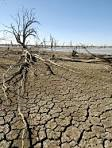| Online: | |
| Visits: | |
| Stories: |
Extreme weather to cause extreme food shortages, task force finds

(Before It's News) The U.K.-U.S. Taskforce on Extreme Weather and Global Food System Resilience found that unless better planning, modeling and trade arrangements are put in place, massive disruptions to our food supply — the kind that usually only occur once a century — will happen every 30 years. Extreme weather in areas that produce our most important crops is largely the cause. A massive drought is already underway in California — the world’s richest food-producing region — causing a loss of 30% of its cropland at a value of nearly $2 billion. The U.S. isn’t alone in feeling the impact of extreme weather. Venezuela is undergoing beer shortages because of a heat wave. Violence has even struck food lines there. Countries that are heavy grain importers will be the most vulnerable to severe food impacts, the task force reported. Egypt has even begun taking steps to thwart shocks to its food supply by boosting wheat production. Food protests and riots broke out there in 2008 when food prices rose sharply. China is also taking preventative steps. Among other strategies to shore up supplies, it is securing agricultural production capacity in sub-Saharan Africa and elsewhere in the developing world. The U.S. and European Union will likely be sheltered from widespread impacts because of strong economies and the ability to outbid other countries for food supplies, the report found. Still, it says global cooperation needs to happen to prevent large food shocks. That means policy and trade agreements that take into account sharing water resources and banning restrictions on certain staple crops. Resiliency efforts are key to battling weather extremes and crop production. India, for example, is highly dependent on monsoon patterns for rainfall. Linked to those patterns is its agricultural system. A dramatic shift in weather could throw off productivity. With a “Godzilla” of an El Nino event predicted for this coming winter season in the U.S., an extreme weather case study on food supplies could be on the horizon. • Countries with high vulnerability to global grain production shocks should take measures to reduce their exposure. • Greater investments in agricultural research should be made to reverse losses in yield-gain and to improve food system efficiencies. • Unsustainable withdrawals of ground water and any unnecessary uses of non-renewable energy should be stopped. • Public-private partnerships, or cooperation between governments and businesses, should be fostered to lessen the potential impact of future global grain production shocks. • Better resiliency efforts should be developed to reduce risks and manage the effects of storms and extreme weather events. We often think of the immediate destruction that weather brings, whether through floods, wildfires, wind or snow. But the effects after the event can be just as serious. Food, shelter and water are the three basic prongs to survival, and all are coming under attack by extreme weather. Thomas M. Kostigen is the founder of TheClimateSurvivalist.com and a New York Times best-selling author and journalist. He is the National Geographic author of “The Extreme Weather Survival Guide: Understand, Prepare, Survive, Recover” and the NG Kids book ” Extreme Weather: Surviving Tornadoes, Tsunamis, Hailstorms, Thundersnow, Hurricanes and More!” Follow him @weathersurvival, or email [email protected]. http://www.wfaa.com/story/news/nation/2015/08/21/extreme-weather-cause-extreme-food-shortages-task-force-finds/32104685/  EXTREME WEATHER TO CAUSE EXTREME FOOD SHORTAGES
EXTREME WEATHER TO CAUSE EXTREME FOOD SHORTAGES
Steps should be taken now to prevent food problems in the future. The task force recommends five solutions:
NESARA- Restore America – Galactic News
Source: http://nesaranews.blogspot.com/2015/08/extreme-weather-to-cause-extreme-food.html

- Karma…. Fact Or Fiction
- Donald Trump draws massive crowd in Alabama
- A Glimpse At Everyday Life Without Running Water
- The Alex Jones Implosion – Dr. David Duke: Official Statement on The Duke-Jones Great Debate
- Do We Care?
- CA: Man who Killed two Robbers found Not Guilty of Murder, Guilty of Weapons Charge
- Finding the Way Forward in a World of Division
- Sacramento special session tackles heath care, infrastructure funding, etc.
- Daily Message ~ Saturday August 22, 2015
- RED ALERT! Another Explosion At Chemical Plant In Shandong China
Portions copyright © 2017 Temporal Media, Inc., All Rights Reserved.
Before It's News® is a registered Service Mark of Temporal Media, Inc..
If you really want to ban this commenter, please write down the reason:


